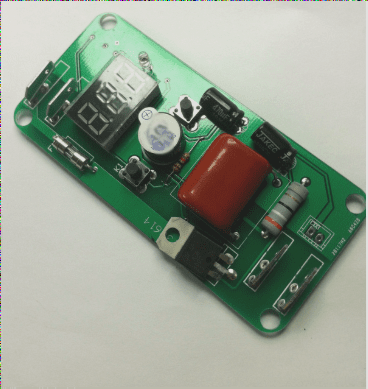Description And Reasons of Poor Plating During PCB Electroplating:
1. Pinhole: Pinholes are caused by hydrogen adsorbed on the surface of the plated parts, which is not released for a long time. This prevents the plating solution from wetting the surface of the plated parts, leading to the inability of the plating layer to be electrolytically deposited. As the coating thickness increases around the hydrogen evolution point, a pinhole is formed, characterized by a shiny round hole and sometimes a small upward tail. Pinholes are easily formed when the plating solution lacks a wetting agent and the current density is high.
2. Pitting: Pitting is caused by an unclean surface of the plated parts, solid matter adsorbed on the surface, or solid matter suspension in the plating solution. When these contaminants reach the surface of the workpiece under the electric field, they get embedded in the electroplating layer, forming small bumps (pits). Pitting is characterized by a convex shape, lack of shine, and irregular shape. In essence, it is caused by dirty workpieces and contaminated plating solution.
3. Airflow streaks: Airflow streaks occur due to excessive additives, high cathode current density, or high complexing agent, which reduce cathode current efficiency and increase hydrogen evolution. When the plating solution flows slowly and the cathode moves slowly, hydrogen gas affects the arrangement of electrolytic crystals, forming streaks against the workpiece surface.
4. Exposure (showing the bottom): Exposure occurs when the soft flash on the workpiece pins is not removed before electroplating, preventing the electrolytic deposition coating. This results in the base material being visible after plating.
5. Brittle coating: Brittle coatings are characterized by cracks in the bends of pins after SMD electroplating and forming. Cracks between the nickel layer and the substrate indicate nickel layer brittleness, while cracks between the tin layer and nickel layer indicate tin layer brittleness. Additives, excessive brightener, or impurities in the plating solution can cause brittleness.
6. Air pocket: Air pockets form due to the workpiece shape and air-trapping conditions, where hydrogen accumulates and prevents electrolysis coating. Proper attention to the workpiece hooking direction during electroplating can prevent air pocket formation.
7. “Tin flower”: Tin plating on the black body forms a “tin flower” due to the exposure of gold wire during plastic packaging, rather than an issue with the plating solution.
8. “Climbing tin”: Dendritic tin layers climbing up the lead and black body junction result from embedded copper powder not properly washed off during pre-plating, creating conductive “bridges” during electroplating.
9. “Whisker tin”: Whisker-like tin formation at the lead and black body junction is caused by exposed silver layers plated during a mask-plating method, which can be improved by addressing silver layer exposure in silver masking technology.
10. Orange peel-like coating: Rough substrates, over-corrosion in pretreatment, or incomplete removal of copper layer can result in an orange peel-like coating on the plated surface.
1. Pinhole: Pinholes are caused by hydrogen adsorbed on the surface of the plated parts, which is not released for a long time. This prevents the plating solution from wetting the surface of the plated parts, leading to the inability of the plating layer to be electrolytically deposited. As the coating thickness increases around the hydrogen evolution point, a pinhole is formed, characterized by a shiny round hole and sometimes a small upward tail. Pinholes are easily formed when the plating solution lacks a wetting agent and the current density is high.
2. Pitting: Pitting is caused by an unclean surface of the plated parts, solid matter adsorbed on the surface, or solid matter suspension in the plating solution. When these contaminants reach the surface of the workpiece under the electric field, they get embedded in the electroplating layer, forming small bumps (pits). Pitting is characterized by a convex shape, lack of shine, and irregular shape. In essence, it is caused by dirty workpieces and contaminated plating solution.
3. Airflow streaks: Airflow streaks occur due to excessive additives, high cathode current density, or high complexing agent, which reduce cathode current efficiency and increase hydrogen evolution. When the plating solution flows slowly and the cathode moves slowly, hydrogen gas affects the arrangement of electrolytic crystals, forming streaks against the workpiece surface.
4. Exposure (showing the bottom): Exposure occurs when the soft flash on the workpiece pins is not removed before electroplating, preventing the electrolytic deposition coating. This results in the base material being visible after plating.
5. Brittle coating: Brittle coatings are characterized by cracks in the bends of pins after SMD electroplating and forming. Cracks between the nickel layer and the substrate indicate nickel layer brittleness, while cracks between the tin layer and nickel layer indicate tin layer brittleness. Additives, excessive brightener, or impurities in the plating solution can cause brittleness.
6. Air pocket: Air pockets form due to the workpiece shape and air-trapping conditions, where hydrogen accumulates and prevents electrolysis coating. Proper attention to the workpiece hooking direction during electroplating can prevent air pocket formation.
7. “Tin flower”: Tin plating on the black body forms a “tin flower” due to the exposure of gold wire during plastic packaging, rather than an issue with the plating solution.
8. “Climbing tin”: Dendritic tin layers climbing up the lead and black body junction result from embedded copper powder not properly washed off during pre-plating, creating conductive “bridges” during electroplating.
9. “Whisker tin”: Whisker-like tin formation at the lead and black body junction is caused by exposed silver layers plated during a mask-plating method, which can be improved by addressing silver layer exposure in silver masking technology.
10. Orange peel-like coating: Rough substrates, over-corrosion in pretreatment, or incomplete removal of copper layer can result in an orange peel-like coating on the plated surface.



